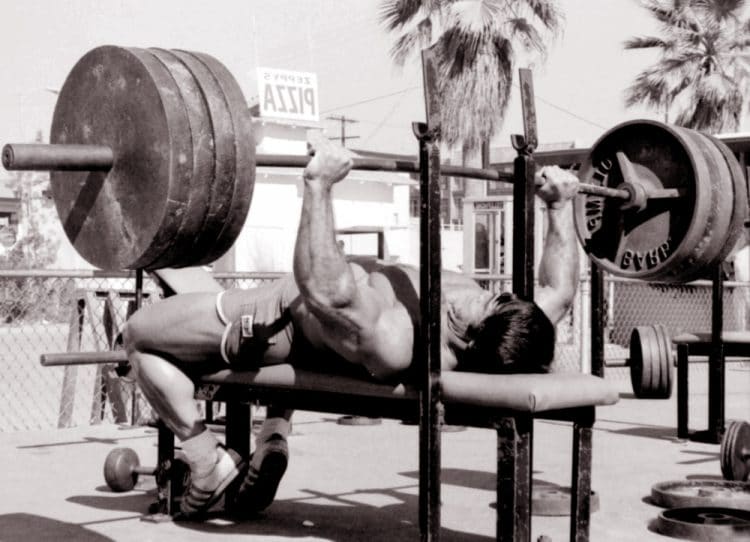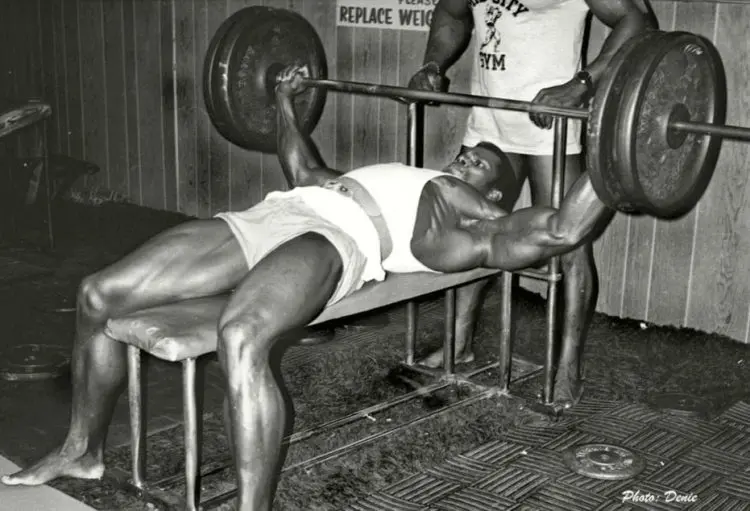The bench press is arguably the most popular strength training exercise. Every Monday is National Bench Press Day, and get two lifters together and, invariably, someone’s going to ask, “Hey bro, how much can you bench?” It’s the second lift contested in powerlifting. Some athletes even specialize in the bench press, shunning almost every other exercise.
As such, a lot of exercisers want to know the secret to benching more.
In this article, we reveal eight proven ways to boost your bench press.
8 Ways to Boost Your Bench Press
Whether you want to increase your 1RM, do more reps with a heavy weight, or just become a more proficient bencher, these are the strategies you need to use!
1. Learn how to bench press properly
The bench press is probably the most widely performed barbell exercise on the planet. Bodybuilders, powerlifters, strongmen, athletes, fitness fanatics, and soccer moms all do it. And yet, despite this popularity, many people still can’t bench press properly.
Common bench press errors include:
Level Up Your Fitness: Join our 💪 strong community in Fitness Volt Newsletter. Get daily inspiration, expert-backed workouts, nutrition tips, the latest in strength sports, and the support you need to reach your goals. Subscribe for free!
- Incorrect hand placement (grip too wide or too narrow)
- Not enough upper back tightness
- No arch
- Bouncing the bar off the chest
- Moving the feet
- Incorrect bar path
These errors create energy leaks that will reduce your bench press performance, both in terms of weight and reps performed. They may even increase your risk of injury.
So, before you start worrying too much about training for a bigger bench, make sure you know how to bench press correctly. In many cases, fixing your technique flaws will automatically put more weight on the bench press barbell.
2. Bench press more often
While Monday is national bench press day, one bench press workout per week is probably not enough to improve your bench press performance. Bench pressing is a skill, and like all skills, it will take time and practice to master.
So, if you are serious about becoming a better bencher, you need to commit to at least two bench press workouts per week. Some highly dedicated lifters may even hit the bench three times per seven days.
But, that doesn’t mean doing the same workout over and over again. That’s just a good way to get bored, sore, and injured. Instead, you need to do different workouts each time you train your bench.
For example:
|
Workout 1 |
Workout 2 | Workout 3 |
|
Regular bench press |
Close grip bench press |
Floor press |
|
Incline dumbbell press |
Push-ups |
Dips |
| Pec deck | Cable crossover |
Dumbbell fly |
In addition to rotating exercises workout by workout, it’s also a good idea to use different set and rep schemes. For example, you might do five sets of five one day, four sets of eight the next, and three sets of 12 after that.
3. Beef up your back
While the bench press is undeniably a chest, triceps, and anterior deltoid exercise, your back plays a critical role in your bench press performance. The back muscles (latissimus dorsi, trapezius, rhomboids, and posterior deltoids) provide a platform from which to push. The stronger that platform is, the more stable you’ll be and the more weight you should be able to lift.
So, as well as training your chest and triceps, you also need to beef up your back if you want to improve your bench press. That doesn’t mean more lat pulldowns and pull-ups, but lots of rows instead. As a rule, you should do one set of rows for every set of bench presses in your workout.
Good bench-boosting rowing exercises include:
Level Up Your Fitness: Join our 💪 strong community in Fitness Volt Newsletter. Get daily inspiration, expert-backed workouts, nutrition tips, the latest in strength sports, and the support you need to reach your goals. Subscribe for free!
4. Increase your strength off your chest
A lot of bench pressers are guilty of bouncing the bar off their chests. This takes advantage of the elasticity of your rib cage and the stretch-shortening reflex, or SSR for short.
While bouncing may help you lift more weight, it’s basically cheating because your muscles aren’t so responsible for lifting the weight. It’s also a sneaky way to bypass a common bench press sticking point.
So, instead of bouncing the weight up, use special accessory exercises to increase your actual strength off your chest.
Useful exercises for fixing this sticking point include:
- Paused bench press – hold the bar on your chest for 2-3 seconds per rep
- Dead-stop bench press – rest the bar on power rack pins between reps
- Speed bench press – using a lighter weight, drive the bar up as fast as you can from your chest
- Plyometric push-ups
5. Train your lockout
The other most common sticking point in the bench press is the lockout. In other words, you get the bar off your chest but can’t complete your rep. Invariably, this is caused by weak triceps combined with a lack of speed off your chest.
A faster bench press will help you power through this sticking point, but so too will beefing up your triceps. However, you’ll need more than triceps pushdowns and kickbacks to strengthen your lockout. Instead, you need to do some bench press-specific accessory exercises.
Good exercises for training your bench press lockout include:
- Floor presses – done with a barbell or dumbbells
- Spoto press – stop with the bar about 6-8 inches above your chest
- Board presses – lower the bar to a 4 to 6-inch block resting on your chest
- Close grip bench press – hands about 12-18 inches apart
6. Make the bench press harder
It’s only by overloading your body that you force it to get stronger and build more muscle. Unfortunately, easy workouts won’t cut it.
So, include some harder bench press variations on your workouts so that, when you go back to regular bench presses, they won’t feel as demanding. Like they say in the military – you’ve gotta train hard to fight easy.
Good options include:
- Bench press with bands or chains
- Bench presses with weights hanging from the bar to create instability
- Single-arm dumbbell bench presses
- 1 ½ rep bench presses – lower the bar as usual, push it halfway up, lower it back to your chest, and then lockout as normal
7. Learn to love push-ups
The push-up is a massively underrated bench press assistance exercise. The movement is very similar, it works the same muscles, and, best of all, you can do it anywhere and anytime.
If you want to boost your bench press but are unable to commit to several bench press workouts a week, the humble push-up could help.
Get into the habit of doing 50-100 push-ups at least five days a week. You can spread your reps out throughout your day or do them all together as preferred. Do regular, wide grip, and close grip push-ups to avoid overtraining and boredom.
Supplement your push-ups with band pull-aparts to strengthen your upper back and prevent muscle imbalances. This should take no more than 10-15 minutes per day but should have a noticeable impact on your bench press performance.
8. Gain weight to lift more weight
It’s no coincidence that some of the strongest bench pressers on the planet are also the biggest and heaviest. In fact, it’s often said that it takes mass to lift mass.
Interestingly, lifters who lose body weight tend to see a decline in their bench press performance but lose less strength in the squat and deadlift. So, there seems to be a close relationship between body weight and a big bench press.
If you are serious about boosting your bench press, it’s time to consider bulking up and increasing your bodyweight. That doesn’t mean you should get fat. Instead, you should increase your functional muscle mass all over your body.
You will probably gain some fat during a bulk, but that’s just part and parcel of this process, but you can always cut down and lean out once you’ve brought your bench press up to the required level.
You can read more about bulking here.
More Bench Press Workouts:
- 6 Bench Press Programs For A Big Powerful Chest
- Hit a Bench Press PR With The Smolov Jr. Program
- Developing Strength With The Powerlifting Bench Pyramid Program
Boost Your Bench Press – Wrapping Up
A big bench press doesn’t happen by accident. It takes time, practice, and perseverance. It’s also worth mentioning that some people simply aren’t built to be big benchers. Unmodifiable factors like long arms, narrow shoulders, or a shallow chest will limit your ultimate bench press performance.
That said, regardless of your genetics, you should still be able to improve your bench press performance if you work at it. So, don’t leave it to chance; use these strategies and techniques to build a bigger bench press.













